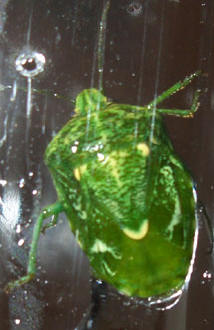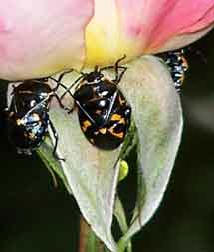 This summer has been a bad one for bugs—at least for bad bugs. The stink bug is a bad
bug; that is it sucks the life out of plants! Stink bugs (Heteroptrera) are attractive bugs. The can be green, brown, gray, or yellow and some have red or yellow markings. I
should mention that not all stink bugs are bad—some of them are predatory on other insects.
This summer has been a bad one for bugs—at least for bad bugs. The stink bug is a bad
bug; that is it sucks the life out of plants! Stink bugs (Heteroptrera) are attractive bugs. The can be green, brown, gray, or yellow and some have red or yellow markings. I
should mention that not all stink bugs are bad—some of them are predatory on other insects.
This summer has also been a good one for bugs. There have been so many butterflies, moths, bees, wasps, flower flies and other pollinating insects on
the flowers. Having dry, sunny weather will encourage all of these pollinators to visit your flowers. It helps to have a lot of flowers that definitely attract bugs—single
flowers rather than double (hollyhocks), flowers in clumps (goldenrod), and flowers in masses (asters). These are just some examples of ways you can attract good insects.
|

Green stink bug
|
Back to the bad bugs. The green stink bug attacks many food crops such as blackberry, cabbage and other members of the mustard family, corn, tomato,
eggplant, bean, soybean, and trees such as apple, peach, pecan, and cherry.
The harlequin bug, Murgantia histrionica, a red and black-spotted species of stink bug, is an important pest of crops in the mustard family in the
southern United States. The word southern is important in this case. Harlequin bugs have now crossed the Mason-Dixon Line to become part of the North and are doing their best
to harm our ornamental plants, including columbine, snapdragon, sunflower, and most important to me—spider flower (Cleome).
In the middle of the summer someone asked a question: What is the red and black bug destroying her Cleome—none of us at the Ask the Master Gardener
booth knew the answer. They say that the best way to learn something is to experience it, and soon I did know what that bug was.
|

Harlequin Stink Bug
|
It appeared on my spider flowers and at the end of September is still sucking the leaves dry. The bugs are very similar in appearance through all
their nymph stages and have piercing-sucking mouthparts which they insert into the leaves, flowers, buds, fruit, and seeds of host plant to suck plant sap. Damage also can
include yellow or white blotches on leaves, misshapen or aborted fruits, seeds, and buds; calluses, blemishes or depressions; and black pits on nuts. Tomatoes exhibit pale
yellow spots and a white pithy area just under the skin at the puncture site. Peaches and other fruits may develop scarring and dimpling, resulting in cat-facing or a pitted
appearance. The seeds in soybean pods may be deformed, small, discolored, or shriveled.
You may think it’s too late to read about an insect that was prevalent in summer and will soon freeze if it hasn’t already. Here’s why it is important
now. The stink bug over winters as an adult in protected areas such as under dead weeds, leaf litter, or the bark of trees. In early summer, the female lays clusters of eggs
on the underside of leaves. These eggs are barrel or keg-shaped with a circular lid. In one to three weeks, the young hatch into wingless nymphs that resemble small adult
stink bugs, although the coloration may differ from that of the adult. The nymphs will molt several times before developing wings and becoming an adult.
To have fewer harlequin bugs next year you should implement some Integrated Pest Management
Strategies:
- Sanitation: Control weeds in susceptible crops and in areas adjacent to gardens to decrease breeding and over-wintering habitat. It is important to
remove weeds early in the growing season before stink bug populations increase or the loss of habitat may force pests to move into the garden.
- Collect insects: Hand pick and destroy eggs and bugs.
- Use Natural Controls: Encourage other natural predators such as parasitic wasps and flies by growing small-flowered plants. The unpleasant odor
produced by stink bugs deters many predators but several bird species do consume these pests.
- Use trap crops: Plant trap crops of mustard and treat that area with an appropriate pesticide.
- Use insecticides: If damage is severe, use insecticidal soap, sabadilla, pyrethrin, or permethrin.
It may be too late this year for many of these practices but you can clean up the weeds and litter and it’s a good idea not to add this litter to your
compost pile. Next spring, resolve to keep weeds under control, add plants to your garden to attract beneficial insects and keep a watch out for a pretty bug that can turn
into a huge pest.
Read other articles about controlling insects & garden pests
Read
other articles by Martie Young